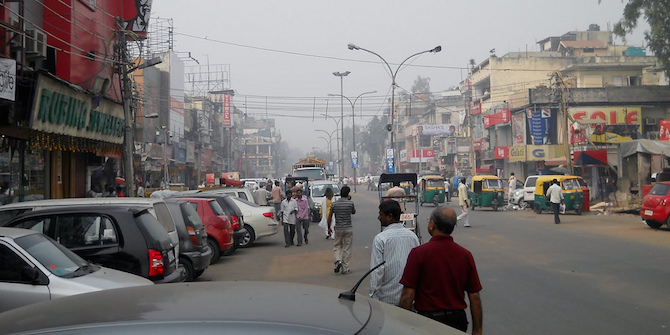India will need to invest over $1.2 trillion in its cities to cope with the hundreds of millions that are expected to move to urban areas in the next 20 years. Savvas Verdis argues this provides an opportunity for ‘Infrastructure Democracy’, where development is structured so that the benefits are spread to all participating cities.
will need to invest over $1.2 trillion in its cities to cope with the hundreds of millions that are expected to move to urban areas in the next 20 years. Savvas Verdis argues this provides an opportunity for ‘Infrastructure Democracy’, where development is structured so that the benefits are spread to all participating cities.
I have just come back from Delhi, where I attended LSE Cities’ Urban Age conference on the future of urban governance. How ready are India’s cities for the mass wave of urbanisation that is going to take place in the country? Unsurprisingly, such expansion will require big infrastructure investment in the 500 or so cities that the government is planning to expand or to create from scratch. My feeling is that this big infrastructure spending is going to concentrate power centrally, whereas there is a big opportunity to incentivise cities in what I call an ‘Infrastructure Democracy’.
First, some facts. India will need to spend over $1.2 trillion over the next 20 years, expanding its cities and building entirely new ones to house the over 250 million people that it is expecting to move into urban areas according to an influential McKinsey report. Most of these cities will lie along so-called corridors of heavy infrastructure investment. A former minister for industry told me that India is finally embarking on its long overdue labour-intensive industrialisation process and that the corridors will be one of the main vehicles to achieving this. The aim is to develop these corridors in an efficient and equitable way. Below are two ways that these corridors can be structured financially and legally so that the benefits are spread to all participating cities.
Pool your funds: Only last week, India launched in London its first ‘Massala Bond’ of $2 billion linking international savings to India’s infrastructure investment. Coupled with the bond market, India will be tapping into sovereign wealth funds and development bank investments. The Delhi-Mumbai corridor is tied for example to Japanese development funds. The money is there and the longer the global economy is providing low yields elsewhere, the infrastructure sector will continue to flourish. If Prime Minister Modi’s enthusiasm of a new infrastructure finance hub in Sydney announced at the G20 last week, is to go by, he will be looking for more FDI for even more corridors. My concern with this model is that it does not fully explore the great work that India has done on pooled city bonds, which is a way of bringing smaller cities together in raising necessary finance for infrastructure projects. The current model is over-centralised – with the national government doing most of the revenue generation. This may be quicker to implement but the opportunity to financially motivate the smaller cities in the corridors to make the right decisions is crucial. They need to bear the benefits or costs if these projects fail. Becoming part of a pooled bond that spreads the risk between larger and smaller cities is an incentive for team work. There is another element here. These corridors can push India’s economic policy either along the German or the English industrial model. Go down the German model, and smaller competitive cities will play a key role in the value chains of major productions centres along the corridors – think of the Mittelsdant. Go the English model and smaller cities get inundated from a London-like powerhouse. It is better for cities to do the positioning themselves rather than central government doing it for them. Being major shared debt holders for the project will incentivise good planning between these centres. Of course this will need to be balanced with the greater level of municipal debt that is going to exist in cities but this will also force them to build less white elephants.
Don’t fall in the land trap: Corridors, such as the Delhi-Mumbai link are land intensive beasts. The business as usual delivery model involves an agency such as a development corporation doing the land acquisition often by compulsory purchase order. This is easier on empty green land but more difficult on land with formal and informal tenures that is heavily politicised. All too often this results in a high level of displacement of households and businesses. Households and businesses should be given some choice here. Firstly, planners should purchase land at the periphery of project areas so that the relocation happens locally and that important social networks are not broken. If the relocation is even further away, planners need to integrate them on the new infrastructure networks. Because the corridors are being laid out now – land needs to be allocated for any resettlement along these routes and not in disconnected areas. Finally, allow households and firms to play the real estate game. Rather than simply using eminent domain, give them the option of owning a share of freehold of the corridor land. Leasehold proceeds can then flow to a larger pool of stakeholders.
The two lines of thought above are a way of redistributing both the benefits and the costs of India’s new urban corridors. Less emphasis on the central state and development corporations and more emphasis on connecting firms, households and cities through legal and financial structures so that the rewards of urbanisation are shared. These will empower Indian cities, that have long been playing catch up, but only if they are networked in these corridors effectively.
Networking cities in such a way creates a new type of regional democracy. Let’s not forget that this is exactly how democracy kick-started under Cleisthenes some 2,500 years ago. Cleisthenes, basically thought that to really create a balanced democracy he had to mix villages with different economic output together. This meant taking a village from the plains, shores and mountains of the Athens region with very different crop productivity yields to create a political entity. There were around 10 such political entities that made up the ‘Athenian people’. These entities had no administrative boundaries to avoid NIMBYism, but they had to work together for the common benefit. Infrastructure democracy can play a similar role. Here are different cities in India that will be part of a value chain heavily influenced by these corridors – some will be lower, some will be higher in that value chain. The point is to mix them in such a way that they reap the benefits fairly. Of course, one cannot plan value chains. Firms will break off from less profitable roots and seek others nationally and globally. Infrastructure democracy, tying cities from a financial and legal sense at the point of design – means that revenues will at least be flowing to lagging areas because of their original contracts. The central government started the process but it should let these corridors of cities take central responsibility for this type of redistribution to continue.
This post originally appeared on the LSE Cities website on 27th November 2014.
Cover image credit: flickr/Mick_Gallagher_1959
About the Author
 Savvas Verdis is Senior Research Fellow at LSE Cities and an Infrastructure Economist at Siemens
Savvas Verdis is Senior Research Fellow at LSE Cities and an Infrastructure Economist at Siemens







